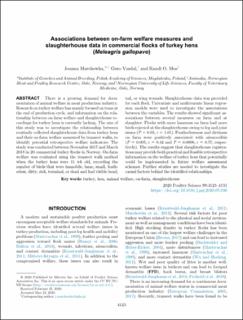| dc.description.abstract | There is a growing demand for documentation of animal welfare in meat production industry. Research on turkey welfare has mainly focused on toms at the end of production cycle, and information on the relationship between on-farm welfare and slaughterhouse recordings for turkey hens is currently lacking. The aim of this study was to investigate the relationship between routinely collected slaughterhouse data from turkey hens and their on-farm welfare measured by transect walks, to identify potential retrospective welfare indicators. The study was conducted between November 2017 and March 2018 in 20 commercial turkey flocks in Norway. On-farm welfare was evaluated using the transect walk method when the turkey hens were 11 wk old, recording the number of birds that were immobile, lame, small, featherless, dirty, sick, terminal, or dead and had visible head, tail, or wing wounds. Slaughterhouse data was provided for each flock. Univariate and multivariate linear regression models were used to investigate the associations between the variables. The results showed significant associations between several measures on farm and at slaughter. Flocks with more lameness on farm had more birds rejected at the slaughterhouse owing to leg and joint issues (P = 0.03, r = 1.01). Featherlessness and dirtiness on farm were positively associated with airsacculitis (P = 0.005; r = 0.42 and P = 0.0008; r = 0.57, respectively). The results suggest that slaughterhouse registrations may provide both practical and feasible retrospective information on the welfare of turkey hens that potentially could be implemented in future welfare assessment schemes. Further studies are needed to investigate the causal factors behind the identified relationships. | |
